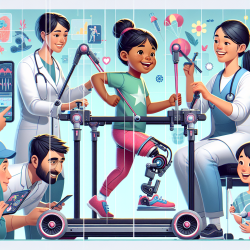Revolutionizing Cerebral Palsy Therapy: A Data-Driven Approach
In the realm of pediatric rehabilitation, particularly for children with cerebral palsy (CP), the quest for improved therapeutic outcomes is relentless. A recent study titled "Comparison of a robotic-assisted gait training program with a program of functional gait training for children with cerebral palsy: design and methods of a two group randomized controlled cross-over trial" sheds light on innovative approaches that could transform therapeutic practices.
The Study at a Glance
This groundbreaking study explores the efficacy of Robotic-Assisted Gait Training (RAGT) compared to traditional physical therapy (PT) in enhancing the gross motor skills of children with CP. Conducted as a two-group randomized controlled cross-over trial, the research provides a comprehensive analysis of both interventions, focusing on motor learning principles and individualized mobility-based goals.
Key Findings and Implications
The study's results are promising, indicating that RAGT can lead to significant improvements in gross motor function, gait velocity, and endurance. Here are some key takeaways for practitioners:
- Enhanced Motor Skills: RAGT has shown moderate to large improvements in gross motor skills, which are crucial for the functional mobility of children with CP.
- Increased Gait Velocity: The robotic assistance allows for faster and more variable gait speeds, which can be beneficial in promoting motor learning.
- Improved Endurance: The endurance gains observed in the study suggest that RAGT can help sustain physical activity levels, which is vital for overall health and quality of life.
Why This Matters
For practitioners, these findings underscore the potential of integrating RAGT into therapeutic regimens for children with CP. The use of robotics in therapy not only aligns with modern technological advancements but also addresses some of the limitations of traditional PT methods, such as the need for extensive manual assistance.
Encouraging Further Research
While the study provides compelling evidence of the benefits of RAGT, it also highlights the need for further research to explore its long-term effects and potential integration with other therapeutic modalities. Practitioners are encouraged to delve deeper into the data and consider how these insights can be applied to enhance therapeutic outcomes.
Conclusion
As we continue to seek better outcomes for children with CP, embracing data-driven approaches and innovative technologies like RAGT can pave the way for more effective and personalized therapies. By staying informed and open to new methodologies, practitioners can significantly impact the lives of children with CP.
To read the original research paper, please follow this link: Comparison of a robotic-assisted gait training program with a program of functional gait training for children with cerebral palsy: design and methods of a two group randomized controlled cross-over trial.










